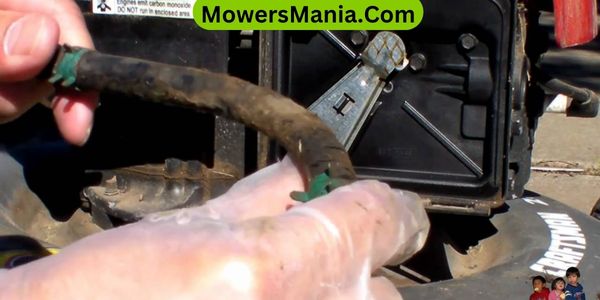If your lawn mower engine fuel line is clogged, it can be as frustrating as trying to drink through a straw with a blockage. Cleaning the fuel line is a simple task that can improve your mower’s performance.
With a few basic tools and some easy steps, you can have your lawn mower running smoothly in no time.

Understanding the Fuel System
To properly clean a lawn mower engine fuel line, you should begin by understanding the fuel system’s components and their functions. The fuel system includes the fuel tank, fuel line, fuel filter, carburetor, and primer bulb.
The fuel tank stores the gasoline, while the fuel line carries the fuel from the tank to the carburetor. The fuel filter prevents dirt and debris from entering the carburetor and potentially clogging it.
The carburetor mixes the fuel with air to create a combustible mixture for the engine, and the primer bulb is used to manually pump fuel into the carburetor to aid in starting the engine.
Understanding these components and their functions is essential in effectively cleaning the fuel line.
By comprehending how each part of the fuel system works, you can identify potential issues that may be causing the fuel line to clog or become contaminated.
This knowledge will also enable you to pinpoint the exact location of the fuel line and its connection points within the system, making it easier to access and clean.
Therefore, taking the time to familiarize yourself with the fuel system’s components and operations is a crucial first step in properly maintaining and cleaning the lawn mower engine fuel line.
Gathering Necessary Tools and Materials
You will need basic tools and materials to clean the lawn mower engine fuel line.
Here’s what you should gather before starting the cleaning process:
- Basic Tools:
- Screwdriver: To remove the engine cover and access the fuel line.
- Safety Gloves: Protect your hands from dirt, fuel, and any sharp edges while working on the engine.
- Materials:
- Clean Cloth: Use it to wipe off any dirt or fuel spills from the fuel line and surrounding area.
- Fuel Line Cleaner: An essential solvent to dissolve any clogs or debris inside the fuel line.
Having these tools and materials at hand will ensure a smooth and efficient cleaning process. Once you have everything ready, you can proceed to the next steps of cleaning the lawn mower engine fuel line.
Removing the Fuel Line

To remove the fuel line:
- Unscrew the engine cover using a screwdriver while wearing safety gloves to protect your hands.
- Once the engine cover is removed, locate the fuel line connected to the fuel filter.
- Pinch the retaining clips on either side of the fuel line with a pair of pliers to release the line from the filter.
- Be cautious as some fuel may still be present in the line.
- Place a rag beneath the fuel line to catch any drips.
- After the fuel line is disconnected from the filter, trace it back to where it connects to the carburetor.
- Again, use the pliers to pinch the retaining clips and carefully remove the fuel line from the carburetor.
- Ensure that the fuel line is free from any obstructions or debris.
- If necessary, gently blow compressed air through the line to clear any blockages.
- With the fuel line successfully removed, proceed with the cleaning process to ensure optimal performance of your lawn mower engine.
Cleaning the Fuel Line
Once the fuel line is removed, inspect it closely for any dirt or residue that may be affecting its performance. Use a clean cloth to wipe the exterior of the fuel line and remove any visible debris.
Next, follow these steps to clean the inside of the fuel line:
- Flush with Cleaner:
- Fill a small container with a fuel line cleaner solution.
- Submerge one end of the fuel line into the cleaner and let it soak for a few minutes.
- Use compressed air to blow through the fuel line, forcing the cleaner and any loosened debris out the other end.
- Inspect and Reinstall:
- After cleaning, carefully inspect the fuel line for any remaining blockages or damage.
- Once satisfied with the cleanliness of the fuel line, reinstall it onto the lawn mower engine.
By following these steps, you’ll ensure that the fuel line is free from any obstructions or contaminants, allowing for a smoother flow of fuel to the engine.
This maintenance will contribute to the overall performance and longevity of your lawn mower.
Reassembling and Testing the Engine

Reassemble and test the engine to ensure proper functioning after cleaning the fuel line.
Start by reattaching the fuel line to the engine, ensuring a secure connection.
Then, reattach any other components that were removed during the cleaning process, such as the air filter, spark plug, and engine cover. Double-check that all connections are tight and secure before proceeding to the testing phase.
Before starting the engine, visually inspect the fuel line for any signs of leaks or damage. It’s essential to address any issues before attempting to start the engine.
Once you’ve confirmed that everything is properly reassembled and there are no visible issues with the fuel line, start the engine and let it run for a few minutes. Observe the engine for any irregularities or signs of fuel leakage.
After running the engine for a short period, turn it off and once again inspect the fuel line and its connections. Look for any leaks or loose fittings.
If everything appears to be in order, you have successfully reassembled and tested the engine after cleaning the fuel line.
Frequently Asked Questions [FAQs]
How Often Should the Fuel Line Be Cleaned in a Lawn Mower Engine?
You should clean the fuel line in your lawn mower engine at least once a year. Regular cleaning prevents clogs and ensures efficient fuel flow. Neglecting this maintenance can lead to engine problems and costly repairs.
Can I Use Any Type of Cleaning Solution to Clean the Fuel Line?
You can’t use any cleaning solution to clean the fuel line. Stick to a fuel system cleaner specifically designed for small engines. Using the wrong type of cleaner can damage the fuel line and other engine components.
What Are Some Common Signs That Indicate the Fuel Line Needs to Be Cleaned?
If your lawn mower engine is struggling to start, stalling frequently, or running unevenly, these are common signs that indicate the fuel line needs cleaning. It’s important to address this to maintain optimal engine performance.
Are There Any Specific Safety Precautions to Keep in Mind While Cleaning the Fuel Line?
When cleaning the fuel line, always wear safety goggles and gloves. Make sure the engine is cool before starting. Work in a well-ventilated area and avoid smoking or any open flames. Disconnect the spark plug wire to prevent accidental starting.
Is It Necessary to Replace the Fuel Line if It Is Heavily Clogged or Damaged?
If the fuel line is heavily clogged or damaged, it’s necessary to replace it. Continuing to use a compromised fuel line can lead to engine issues and potential safety hazards. Always prioritize safety when dealing with fuel system components.
Conclusion
Now that you’ve cleaned the fuel line of your lawn mower engine, you can rest assured that it will run smoothly and efficiently.
Regular maintenance like this will extend the life of your mower and keep it performing at its best.
Remember to always follow safety precautions and consult your owner’s manual for specific instructions.
Happy mowing!



